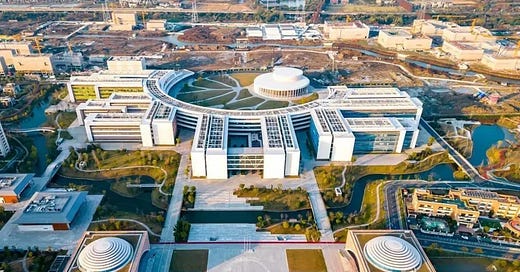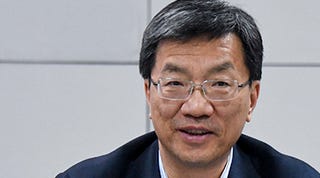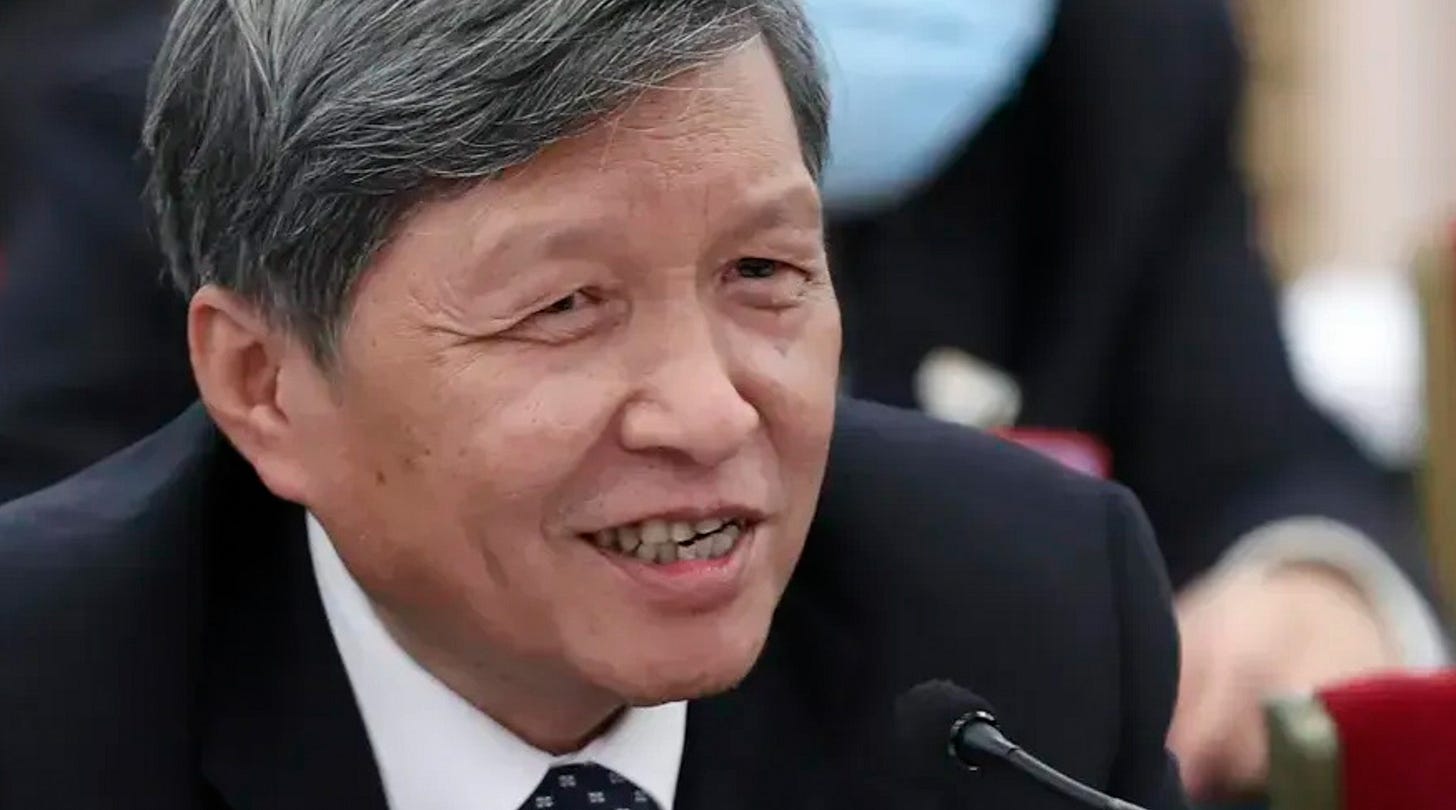universities race to fix graduate skills mismatch
Successive cohorts of PRC university graduates passed 10 million for the years 2022–25, becoming the majority of candidates for urban jobs.
Yet despite high unemployment among young adults, firms struggle to recruit qualified ‘talent’. To solve the mismatch, Beijing is rethinking tertiary education.
Education-industry integration was a priority in upgrading PRC vocational schools as early as 2013. This now extends to universities. Demographic shift and economic transition make it vital to ensure young graduates are trained vocationally ahead of venturing into an ever-tighter labour market.
new universities
New campuses are emerging across the PRC's tertiary sector, which has long been weighed down by hierarchy and inertia.
Training skilled workers in industry, academic and research sectors was a priority at the Two Sessions. Innovative research universities are vital in turning the PRC into an educational power, notes Huai Jinpeng 怀进鹏, Minister of Education. Innovation and interdisciplinary studies of real-world issues must be prioritised, serving strategic emerging industries with less bureaucracy.
Apart from local state funding, much financial support for setting up these innovative research universities comes from industry.
Westlake University, for example, has been funded by Pony Ma 马化腾 Tencent CEO and Wang Jianlin 王健林 Wanda Group board chair
Fuyao Technology University was founded by Cho Tak Wang (Cao Wangde) 曹旺德 Fuyao CEO, who endowed it with C¥10 bn (~USD 1.37 bn) and pledged contuning funding
Shenzhen University of Advanced Technology, affiliated with the Chinese Academy of Science, got some C¥ 5 bn (~USD 690 mn) from the city
reforming university majors
Expanding ‘double first-class’ universities (top campuses) was another Two Sessions’ education priority. STEM majors are growing, but MoE (Ministry of Education) worries that the mismatch with job openings, in part, traces to obsolete majors.
A reform plan emerged in March 2023, aiming to update 20 percent of tertiary courses by 2025. Specialties that did not attract students for five consecutive years were to be withdrawn.
Issued January 2025, an ‘Outline for building China into an education power (2024–36)’ calls for ‘forward planning and dynamic adjustment of academic programs, with enhanced course structures and offerings that meet the needs of the digital economy and future industries.’
In a rush of reforms, campuses nationwide are adding or renewing STEM majors. Meanwhile, majors with fewer employable graduates, such as management, the arts, and literature, are to be trimmed. Nearly 9,000 majors have undergone ‘adjustment’ from 2023 to May 2025, some 14 percent of an original 66,000. The 20 percent goal will be reached at this rate by 2026.
four new disciplines
Developing ‘new’ engineering, medicine, agriculture, and liberal arts was urged by Party leader Xi during an April 2021 inspection of Tsinghua University. These ‘four new disciplines’ aim to integrate R&D and production via disciplinary fusion, hopes Ma Luting 马陆亭 China National Academy of Educational Sciences.
'Double first-class' universities have added some 1,000 new majors in the past five years. Engineering, the dominant tertiary discipline, added 500; sciences were close behind. New engineering majors are primarily in tech innovation and engineering applications, aligning with a strategic direction of 'new engineering’ education.
fast-tracking urgent fields
Shedding red tape, the January 2025 ‘Outline’ proposes to ‘fast-track urgently needed fields, bolster basic research, emerging disciplines, and interdisciplinary areas, while supporting non-viable and niche subjects’. For the first time, it created a ’green channel’, bypassing standard approval timelines.
With application dates for new course registrations already passed in 2024, MoE fast-tracked six universities to set up low-altitude tech and engineering programs, allowing them to begin enrolment in 2025. The sector had been identified as critical in the CPC Central Committee's July 2024 ‘deepening reform’ plenum.
on wings of AI
The 2025 menu of undergrad majors added 29 new specialties, including
low-altitude technology and engineering
geriatric medicine and health
Programs in AI, digital economy, and intelligent manufacturing, meanwhile, proliferated.
AI topped the list of newly added majors in 2025, reports Caixin, in 91 campuses, followed by digital economy (76), and intelligent manufacturing (49).
The 29 new specialties in 2025 venture into four directions
national strategic needs
area studies (supporting BRI and trade)
carbon neutrality science and engineering
marine science and technology
health and medical security
scientific frontiers
intelligent molecular engineering
medical devices and equipment engineering
spatiotemporal information engineering
market demands
international cruise management
aviation sports
pharmaceutical economics and management
AI applications
AI education
intelligent audiovisual engineering
digital drama
aligning universities with regional development
Realigning regions with specialties, MoE piloted programs in Chongqing, Heilongjiang, Henan, Zhejiang, and Shaanxi, creating 172 cross-university sectoral clusters supporting trillion-yuan industries.
The location for building a career becomes critical in the AI era, said Lu Ming 陆铭 Shanghai Jiaotong University's Antai College of Economics and Management.
Distinct industry profiles will emerge, forecast recruitment platform Liepin in Q1 2025, identifying more cities as attractive professional hubs. Skills and population flows, once 'clustered in Beijing, Shanghai and Guangzhou' are ever more 'following the industry map'. Capital-intensive manufacturing jobs, says Lu, are prone to replacement by robots and AI, whereas services, being labour-intensive, create big-city IT and platform jobs.
keeping the record
To better track and connect skills and jobs, the State Council issued 'Opinions' urging a ‘high-quality employment services for university graduates’ on 8 April. They include
a big data database monitoring skills/demand trends
regional and industry-specific graduate job markets
courses dedicated to matching students with internships
‘employability’ as a metric for assessing tertiary offerings
assessing tertiary funding in terms of graduate job quality
MoE primarily relies on recruitment websites for monitoring. With a wealth of platforms available, reducing duplication and standardising enterprise job requirements is challenging, laments Mao Yufei 毛宇飞 Renmin University China Institute for Employment Research. Integrating the data to turn occupational shortages into professional criteria is an uncharted field.
Current graduate employment information, notes Mao, is based mainly on students reporting their job registrations. Yet best practice in resumé submissions, industries and firms to target, etc., are dynamic. Converting registration data into effective advice on the current job market is challenging.
future trajectory
The pattern is clear: more majors will appear that serve strategic emerging industries relied on for growth, and those whose graduates are deemed less employable will be trimmed.
To survive the adjustments, campuses are tempted to rebadge old disciplines with alluring descriptors, e.g. ‘intelligent’ or ‘AI+’, with no real change, warns education pundit Xiong Bingqi 熊丙奇 21st Century Education Research Institute.
‘Fast tracks’ created for urgently needed majors testify to agility in PRC higher education. But an adequate supply of teachers to cultivate the next generation of high-tech workers requires much more action, warns Yuan Liang 袁亮 Chinese Academy of Engineering academician.
education leaders
Huai Jinpeng 怀进鹏 | Ministry of Education Minister
To become a global innovation hub, says Huai, the PRC needs campuses that spearhead basic research, foster education-science-skilled staff development cycles, and reinforce national innovation.
Reform entails improving skills development by aligning disciplines with scientific and national strategic needs; achieving tech independence via cultivating young scientists with sustained policy support and quality-focused evaluation; and enhancing impact through transforming research, campus tech transfer centres, and collaboration with firms.
Education reform is shifting from quantity to quality through educational equity that expands free education, enhances preschooling, improves rural schools, ‘modernises’ governance, offers broader student pathways, including improved vocational options. This is supported by lifelong learning resources available on digital platforms that leverage AI and big data.
Enactment entails blending ideology with holistic development, better regional resource allocation, positioning higher education to lead in innovation, developing technical workers, and expanding international collaboration, all making the PRC an educational power by 2035.
Current MoE minister and a former MIIT vice-minister, Huai, has risen from academia to government. He has served as the President of Beihang University, where he earned a PhD in Computer Software, and joined the Chinese Academy of Sciences in 2009. He visited Columbia University 1995–96 on a scholarship.
Wang Shuguo 王树国 | Fuyao University of Science and Technology president
Campuses have disconnected from society, warns Wang. Society is transformed by a tech revolution that existing institutions fail to address. Universities once led social development; practice now often precedes academic understanding, he observes.
Rather than operating as external change agents, universities must deeply integrate with society. The ‘Four Orientations’ approach urged by Wang responds to global concerns by recognising broad trends, addressing national concerns via world-class ‘Chinese-style’ campuses, meeting demands for high-quality development, and fulfilling expectations for quality education.
Wang envisions a ‘small but excellent, research-oriented and internationalised’, Fuyao University, where students experience society and cutting-edge technology via active learning and critical thinking.
President of Fuyao University of Science and Technology since 2024, Wang was President of Xi'an Jiaotong University (2014–24) and Harbin Institute of Technology (2002–14). An expert in medical robotics and autonomous systems, he holds a PhD from Harbin Institute of Technology and has been a visiting scholar at Arts et Métiers ParisTech (1987–89).
Yuan Liang 袁亮 | Chinese Academy of Engineering academician
By adjusting 20 percent of programs (some 50 per campus) to align with new industries, universities will create about 10,000 new industry-focused programs, training over 1.2 million students. This, Yuan shows, will need at least 24,000 new specialised faculty.
Local campuses, above all in poorer regions, will struggle to find, train, and retain faculty for strategic emerging industries. He proposes three solutions: more funding and policy support for high-level staff recruitment in central and western provinces; direct more innovation platforms and major science projects to local universities there, while creating targeted faculty training; create demo centres for faculty development by selecting 1–2 high-level industry-aligned local campuses in each province, providing special funding and policy support to build some 50 faculty development hubs nationwide.
Elected an academician in the Chinese Academy of Engineering in 2009, Yuan has since 2018 presided over Anhui S&T University, and is an expert in coal mining and coal mine gas control. Chief engineer for 35 years with Huainan Mining Group and Director of China National Engineering Research Centre for Coal Mine Gas Control, he works on mining safety, dust control, and occupational health.








